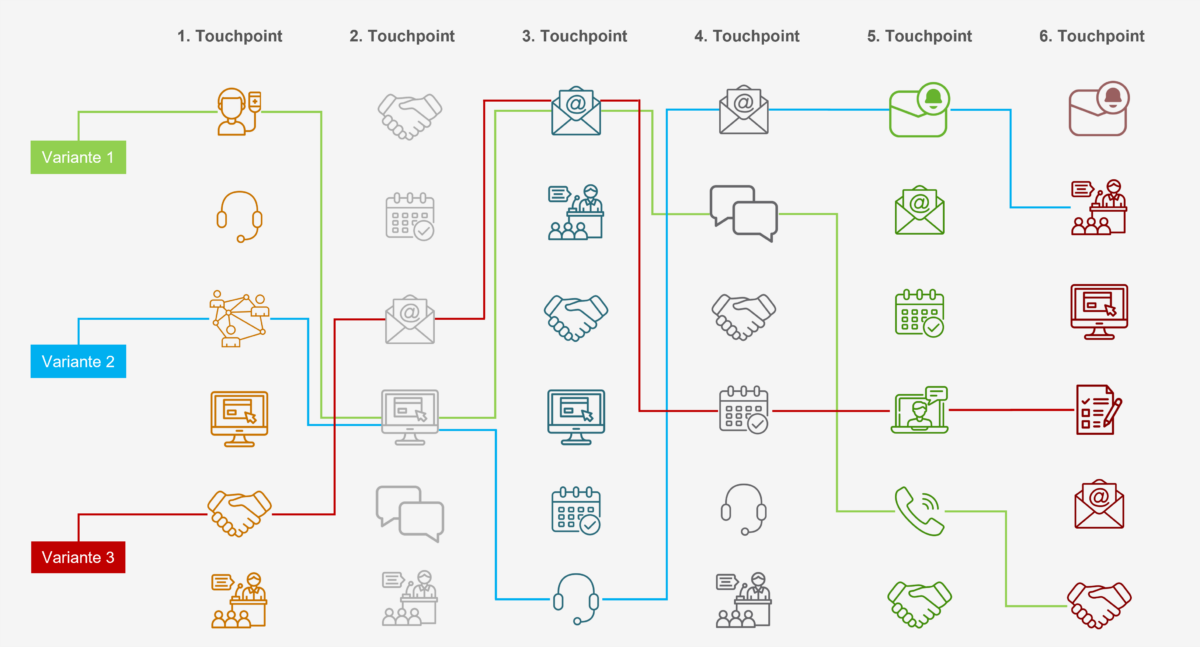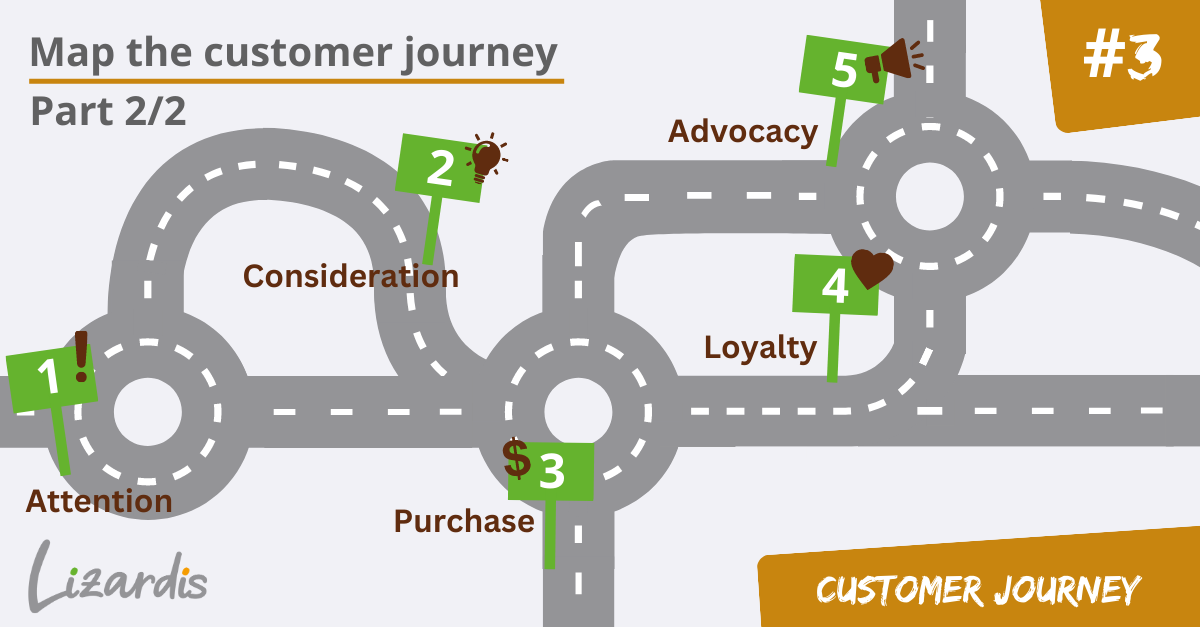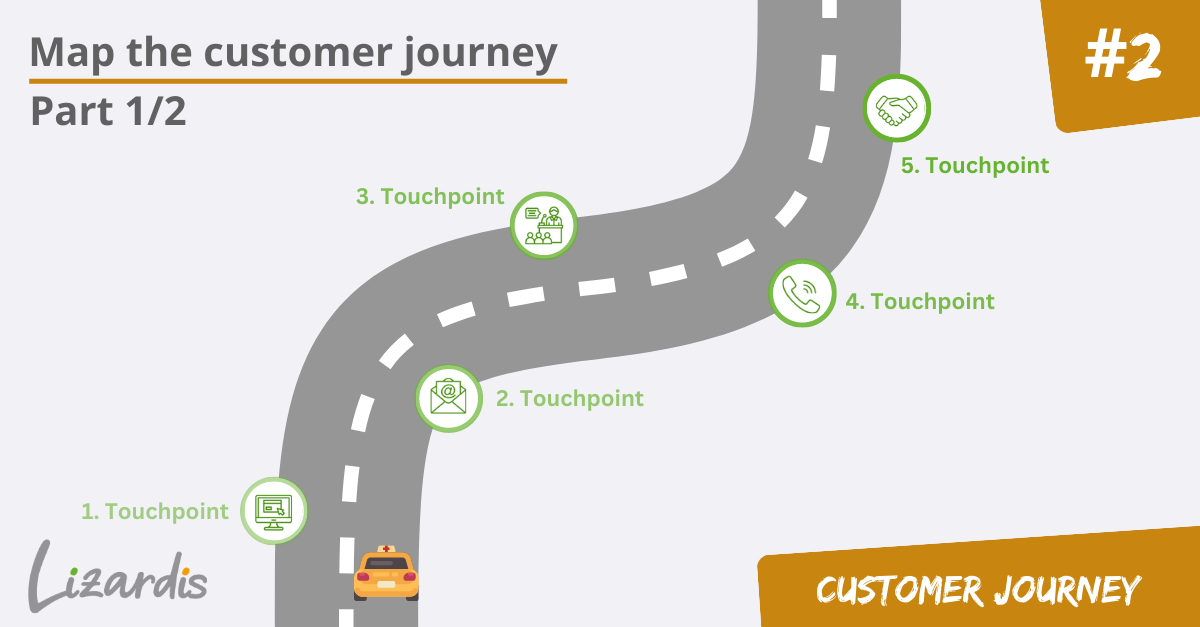Hanover, June 5 2023
In the previous article, I described the customer journey of the life sciences industry and its five phases. In the first part of this article, I would like to explore the question of how a customer journey for a customer can generally be designed and presented. Within the second part of this post, I will examine whether the path described is typically followed or what other paths HCPs may take on their journey.
Preliminary consideration – for which type of customer do we create the Customer Journey Map?
Not all HCPs are the same. It should come as no surprise that there are also different types of customers from the perspective of a life sciences company. These can differ in terms of their areas of expertise and main areas of interest. Personalities also play a significant role, as they result in HCPs wanting to be approached differently. Ultimately, the importance of the individual customer to the life sciences company is another factor that should be considered. A customer with a high prescribing potential is approached differently than an HCP who is convinced of the product but does not have enough patients in his practice to prescribe it to.
The purpose of these preliminary considerations is to avoid the impression that “all HCPs are treated according to the watering-can principle” in the first place. The customer journey and the associated customer experience should become an individual experience – the customer should be at the center. This is why the term customer centricity is used in this context. To accomplish this, marketing develops so-called personas. Personas are fictitious customers who are described as detailed as possible so that the marketer who wants to develop the customer journey map has a clear picture of the customer. From the perspective of a life sciences company, such a persona might look like this:
Persona example
„Linda is an internist, 42 years old, married and mother of 2 children (3 and 7 years old). She lives in her own home, which also houses her practice for internal medicine. Having previously worked in the Internal Medicine Department of the city hospital as a ward physician for 8 years, Linda took over her current practice 4 years ago. She employs 3 physician assistants in her practice, one of whom is a part-time employee. For the past year, she has been supported by another internist (Peter), who works in the group practice three days a week. The patients who visit Linda’s practice have typical internal diseases, first and foremost type II diabetes, as well as cardiovascular diseases. However, she is particularly interested in diseases of the lungs, especially the various forms of pulmonary fibrosis. Her interest in pneumology stems from her work at the internal medicine ward, where she mainly treated lung diseases and was able to gain initial experience with pulmonary fibrosis patients. She is therefore aspiring to become a licensed pulmonologist as a 2nd specialty. In addition to the treatment methods for pulmonary fibrosis in its respective form, she is particularly interested in finding out about its causes and possibilities for early detection and is therefore well networked with other physicians from various specialties. Furthermore, she would be happy to participate in corresponding clinical phase 1 to phase 3 studies.
When treating patients diagnosed with pulmonary fibrosis, Linda is not generally committed to a particular treatment regimen or even product but chooses the therapy and product that seems most appropriate for the patient at the respective stage of the disease. She carefully considers also integrating naturopathic medicine, nutrition, and exercise into the treatment plan if it is possible and appropriate. It is always her main objective to detect the disease as early as possible and to stop its progression to preserve as much quality of life as possible.
In her hometown, a medium-sized city with a population of 200,000, Linda has now made a name for herself on the subject of pulmonary fibrosis, and the number of patients under her care with this or similar diseases has risen steadily over the past three years. Patients with pulmonary diseases now account for 30-40% of her patients. “
Designing customer journey maps based on personas
Our next step is to describe the individual stations on the journey as precisely as possible. What points of contact does the “story” about “Linda” offer to start the journey? Let’s look at different variants for the first touchpoints that Linda could have in the first phase of the customer journey:
Description variant 1:
„Linda becomes aware of our product for the treatment of early-stage pulmonary fibrosis through a new patient. The patient found out about the disease early on through an incidental discovery and started to read up on the subject on the Internet. Linda now does her own research on the product on our website and even registers with her practice email address to gain access to exclusive content for physicians. Using a chat bot on the website, she expresses her desire to be contacted by a pharmaceutical representative who can answer further questions about the use of the product in a direct conversation. The sales representative responsible for Linda’s region contacts Linda immediately and arranges an initial contact with her at her internal medicine practice. “

Description variant 2:
„Linda finds out about our product from a medical colleague within her network and learns that he has already had his first, promising experiences. For example, the progression of the disease slowed down significantly after the first doses. Linda researches the service telephone number via our company’s website and calls the customer service team. She enquires about meaningful study results and how to obtain them. The service representative recommends her to register on our website to gain an initial glance at the relevant specialist information and documented testimonials from HCPs and patients In addition, he also offers to send her the first relevant content directly to her e-mail address, provided that she confirms her initial verbal consent to the use of her e-mail address via the confirmation e-mail that was sent to her. Linda decides to pursue both options. The email subsequently contains information about a medical event planned for her region, which provides details about the various forms of pulmonary fibrosis as well as the different stages of the disease. She then registers for the event, which is organized by our company. “

Description variant 3:
„For the first time, Linda is visited by the sales representative responsible for her city. He is new to our company and visits Linda because her profile marks her as one of his target customers. He introduces himself to Linda and offers her information about our pulmonary fibrosis product. She informs him that she is highly interested in this information and the possibility of using the product. However, she prefers to be able to devote her time in the office to patients. She asks whether it is possible to make contacts by phone or even remotely. The pharmaceutical representative confirms that these options exist, but that he needs her email address and phone number or cell phone number to do so. With her digital signature, Linda gives him permission to use the practice e-mail address and the practice’s landline. The sales representative thanks Linda for her trust and schedules an initial appointment for a video conference. He asks whether her colleague (Peter) is also interested in the topic of pulmonary fibrosis, since the remote call could also be conducted with several people, to which Linda replies in the affirmative. The field representative also discusses with her that he would like to send her a questionnaire after the remote meeting to receive feedback from her about the appointment, to which Linda agrees. “

As we can see, there are many ways in which an HCP can become aware of a product or a life sciences company. The exemplary scenarios described and presented here as well as several other conceivable paths are usually mapped in a campaign management system in marketing. As it is also possible that there are mixed forms or overlaps in the imagined customer journey maps, they are presented next to each other or overlapping each other. This offers the advantage that individual adjustments or entirely new scenarios can be visualized quickly. Finally, omnichannel approaches can also be mapped much more easily in this way, as the following image shows:

Omnichannel marketing approach, extract
Reduce or increase compexity – what is the right approach?
The excerpts from customer journey maps shown here, taken on their own, merely represent different entry scenarios within the 1st phase, in which a potential customer first becomes aware of the product or the life sciences company. It is easy to imagine how the level of complexity increases when customer journey maps are conceived for different personas, for multiple products, and across a variety of channels to different customer journeys, such as the
- development of a prospect into a customer,
- development of a customer into a loyal customer,
- development of a customer into a proponent of a product as well as
- the prevention of customer churn and
- the recovery of former customers.
It is certainly possible to reduce complexity. If the customer journey is not depicted from the customer’s point of view, as is the case here, but e.g., from the perspective of the activity planning of a sales representative who only has a limited number of channels at his disposal, such as
- visits,
- remote meetings,
- rep triggered emails,
- phone calls or
- event attendance by HCPs,
the scope of a customer journey is significantly reduced for different personas.
The same applies from the point of view of marketing, which also only controls some channels, such as
- Corporate emails,
- Website views, registrations, and usage by HCPs,
- chat bots or
- life sciences company app registration and usage.
It is also possible to depict a purely product-oriented perspective. However, such one-sided approaches do not lead to the desired goal of winning and keeping customers on a long-term basis. Today, HCPs expect information and services from life sciences companies to be available to them in a personalized form via a wide variety of channels, with seamless transitions and without time delays. Therefore, emotions should also be described within the customer journey map – positive, neutral, and negative – to identify and counteract weak points in the customer experience – even if this means that the complexity of the customer journey map might increase. For a better understanding of this approach, I will revisit and elaborate on these aspects and some other basic principles in a later post on Customer Experience.
How do I properly use the experience I have gained?
Due to the complexity described, an analysis of the data collected with each touchpoint is necessary, even indispensable. Data collected from HCPs that correspond to the conceived personas must be analyzed to be able to conclude where a customer journey map meets the actual expectations of the customers, but also where it is incorrect and needs to be adjusted. This form of maintenance should take place every 6 months on average as it can reduce the risk of planning past the needs of HCPs. Since the amount of data continues to grow exponentially, life sciences companies are increasingly adopting machine learning and next best action approaches, as we will see in later articles. These concepts help to predict the next steps of the customer’s journey. In this way, recommendations are generated as to which touchpoints are to be expected or integrated into the customer journey. The data obtained in this way is then used with the help of artificial intelligence to optimize the customer journey.
This brings us to the end of the first part. We have gained a first impression of the possible applications for a customer journey in the life sciences environment. In the second part of this article, next week, I will devote myself to the atypical scenarios mentioned at the beginning.
You want more insights?
Check out our other blog articles about customer engagement!
Omnichannel-Management: From product centricity to customer centricity (1/3)
Omnichannel marketing enables the shift from product centricity to customer centricity. Learn more about how it differs from other concepts.
Mapping Life Sciences Customers in the Customer Journey (2/2)
The ideal-typical course of the Customer Journey with phases 1 to 5 not always realistic. Also consider alternative paths that your HPCs follow.
Mapping Life Sciences Customers in the Customer Journey (1/2)
Get to know your customers better by developing customer journey maps for different personas to improve customer engagement.
The Customer Journey in Life Sciences: Taking the customer on a journey – what does that mean?
Develop your contacts along the customer journey into sustainable customers. In our article, we tell you what to look out for in the life sciences environment.






